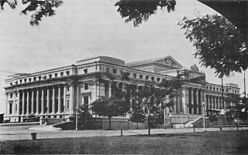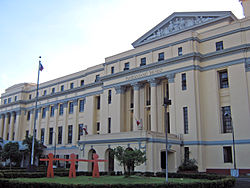- Old Congress Building, Manila
-
Old Congress Building 
The Congress Building in the 1930sGeneral information Architectural style Neoclassical Town or city Manila Country Philippines Construction started 1918 Design and construction Architect Ralph Harrington Doane, Antonio Toledo, Juan M. Arellano The Old Congress Building (also known as the Old Legislative Building) is a building located on Padre Burgos Avenue, Ermita, Manila, Philippines. It is currently home of the National Art Gallery of the National Museum of the Philippines. From 1926 to 1972, and again from 1987 to 1997, the building was home to various legislative bodies of the Philippine government.
Contents
History
 SEATO member states' leaders at the Congress Building in 1966. Philippine president Ferdinand Marcos is fourth from left.
SEATO member states' leaders at the Congress Building in 1966. Philippine president Ferdinand Marcos is fourth from left.
 The current state of the building, as home of the National Museum.
The current state of the building, as home of the National Museum.
The building was originally designed by Ralph Harrington Doane and Antonio Toledo in 1918, and was intended to be the future home of the National Library of the Philippines, according to the Plan of Manila of Daniel H. Burnham.[1] Meanwhile, a Capitol building for the Philippine Legislature (established on October 16, 1916) was to rise on Wallace Field, just south of the library (the location is now María Y. Orosa Street in Rizal Park). Instead, the Philippine Legislature decided to move into the Library building in 1926, and changes to the building's layout were done accordingly by architect Juan M. Arellano.[1] The building therefore became known as the Legislative Building. The Second Regular Session of the 7th Philippine Legislature was formally opened at the building on July 11, 1926. It was concurrently the headquarters of the National Library from 1928 to 1944.
In 1935, the Commonwealth of the Philippines was inaugurated, and the inauguration ceremonies and oath-taking of President Manuel L. Quezon were held outside the building. The building became home of the National Assembly of the Philippines, and it was subsequently known as the National Assembly Building. In 1940, the National Assembly was replaced by a bicameral Congress of the Philippines, consisting of a Senate and House of Representatives. The Senate occupied the upper floors while the House occupied the lower floors. The building would serve as home of the Commonwealth Congress until 1945.
In World War II, Japanese forces in Manila bombed and destroyed the building. Most of the structure was beyond repair, except for the still-standing central portion.[2] With the inauguration of the Republic of the Philippines in 1946, the building was to be reconstructed to be the home of Congress. Reconstruction began in 1949, while the Congress moved back the same year. The two wings of the building were completed in 1950.[2] The building was rebuilt mostly from memory, with the aid of a few remaining blueprints.
The building became known as the Congress Building, and continuously served as home of the Congress of the Philippines until 1972 with the declaration of martial law. The Congress was effectively dissolved, and the building was padlocked. For a short time, the building became home of the offices of the Prime Minister of the Philippines, a position established under the 1973 Constitution of the Philippines. The building was called the Executive House for the duration of that time.
The Congress of the Philippines was reestablished with the ratification of the 1987 Constitution of the Philippines. While the House of Representatives moved to the Batasang Pambansa Complex in Constitution Hill, Quezon City, the Senate used the original Congress Building for their plenary sessions.
The Senate would use the Congress Building until May 1997, when it moved to the GSIS Building on reclaimed land on Manila Bay in Pasay.
The building was then turned over to the National Museum of the Philippines, and presently houses the National Art Gallery.
On September 30, 2010, the National Historical Commission of the Philippines declared the building as a "National Historical Landmark" by virtue of Resolution No. 8 (dated September 30, 2010).[1] A marker commemorating the declaration was unveiled on October 29, 2010.[1]
See also
References
External links
- Arkitekturang Filipino - www.arkitektura.ph - National Museum of the Philippines Building (Old Congress Building)
- History of the Senate of the Philippines
- History of the House of Representatives of the Philippines - Former Buildings
- NHCP declares Old Legislative Building as National Historical Landmark
Government
cultural
agenciesNational Commission for Culture and the Arts · National Historical Commission of the Philippines · National Museum · National Library · National Archives · Cultural Center of the Philippines · Komisyon sa Wikang Filipino · Sentro Rizal
Categories
of cultural
propertiesUNESCO World Heritage Sites · National Cultural Treasures · Important Cultural Properties · National Historical Landmarks · National Shrines · National Monuments · National Heritage Houses · Works of National Artists · Marked Structures · Other Cultural PropertiesCategories:- Buildings and structures in Manila
- History of the Philippines
- Legislative buildings
- National Historical Landmarks of the Philippines
- Neoclassical architecture in the Philippines
- Seats of national legislatures
Wikimedia Foundation. 2010.
